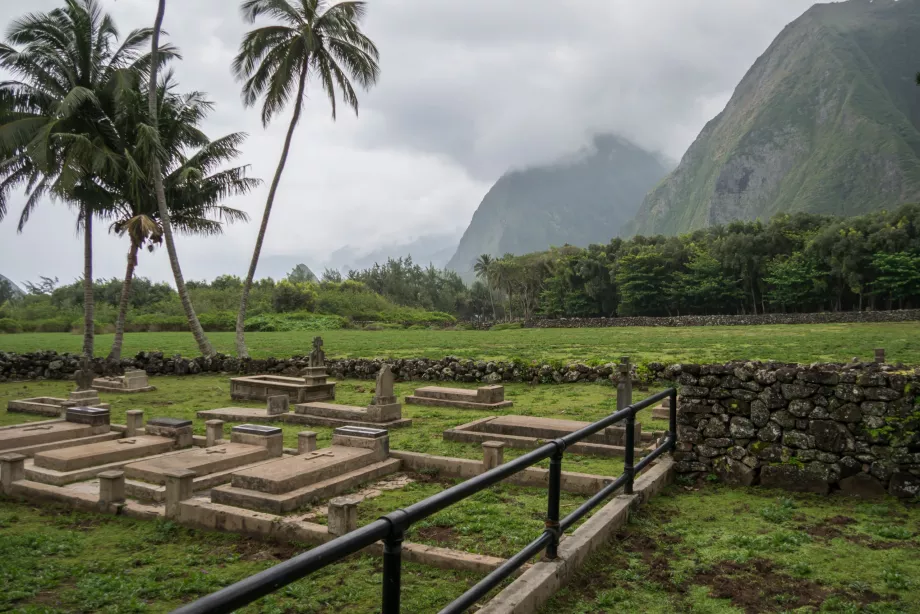Kalaupapa

The small village located on the peninsula of the same name at the foot of the highest sea cliffs in the world is almost completely cut off from the world thanks to them.
The only way to Kalaupapa is a steep 5.5 km long footpath that exceeds 610 metres and is often prone to landslides and therefore impassable at that time.
It was because of its almost complete isolation from the outside world that Kalaupapa was chosen in the late 19th century as a leprosarium - a quarantine site for leprosy patients.
Cheapest accommodation on Molokai
As of 2023, all organized tours to Kalaupapa have been discontinued and it is currently impossible to visit the village.
History of the leprosy colony
The leprosy colony in remote Kalaupapa was established by King Kamehameha V in 1866. This was at a time when leprosy was a highly infectious incurable stigmatised disease and patients were transported to isolated leprosaria.
The Kalaupapa leprosarium was in operation until 1969 when the last patient recovered or was treated with new antibiotics. However, those affected by leprosy were allowed to settle permanently in Kalaupapa and many took up the offer, which is why the village of Kalaupapa is still inhabited today.
A prominent figure in the running of the leprosarium in Kalaupapa was Father Damien, a Belgian Roman Catholic priest who had lived in the Hawaiian Islands since 1873, where he served as a missionary and helper to lepers. He lived and helped the sick in Kaulapapa until his death in 1889, when he succumbed to leprosy.
Present day Kalaupapa
At present there are about 100 permanent residents in Kalaupapa, mostly descendants of patients.
Kalaupapa is an autonomous village with its own administration and, even by today's standards, is very closed off from the world. Historical reminders of the leprosarium era include several monuments, a cemetery with a larger memorial, and St. Philomena's Church about 2 km from Kalaupapa in an area called Kalawao, where the very original leprosarium operated for the first few years before moving to Kalaupapa.
From St. Philomena's Church you also have the most beautiful views of the highest sea cliffs in the world around Umilehi Point.
Visit Kalaupapa
Kalaupapa is part of the Kalaupapa National Historical Park. While there is no entrance fee as such, a trip to Kalaupapa will still be quite expensive. The village cannot be visited without a so-called inviting person, which can be any of the official agencies organizing trips to Kalaupapa.
Detailed information can be found on the official website: nps.gov/kala/planyourvisit.
As of 2023, all organized tours to Kalaupapa are discontinued and it is currently not possible to visit the village.
The agency offers three modes of transportation to Kalaupapa if the village opens:
- Invitation permit + walking the Kalaupapa Trail, one of the steepest trails in the entire Hawaiian Islands (cost around 100 usd)
- Donkey or mule ride on the Kalaupapa Trail (price around 250 usd)
- Flight from Honolulu, Maui or the Big Island directly to the small Kalaupapa airport + van transfer to the village (prices between 430 usd and 550 usd)
While there is also a scheduled Mokulele Airlines flight to Kalaupapa Airport, unless you have an official invitation from a Kalaupapa resident, you cannot purchase a separate ticket.
As hinted at in the introduction, the Kalaupapa Trail is often plagued by landslides, and at such times only expensive air travel from nearby islands is possible.
The daily number of visitors to Kalaupapa is limited to 100, so book your trip at least a week in advance through the websites of the agencies mentioned above. Entry is not permitted for persons under 16 years of age.
You cannot stay overnight in Kalaupapa unless you have an invitation directly from some of the locals.
What to see around
Discover all the places to see in Molokai.
Any questions left?
If you have any questions or comments about the article...

